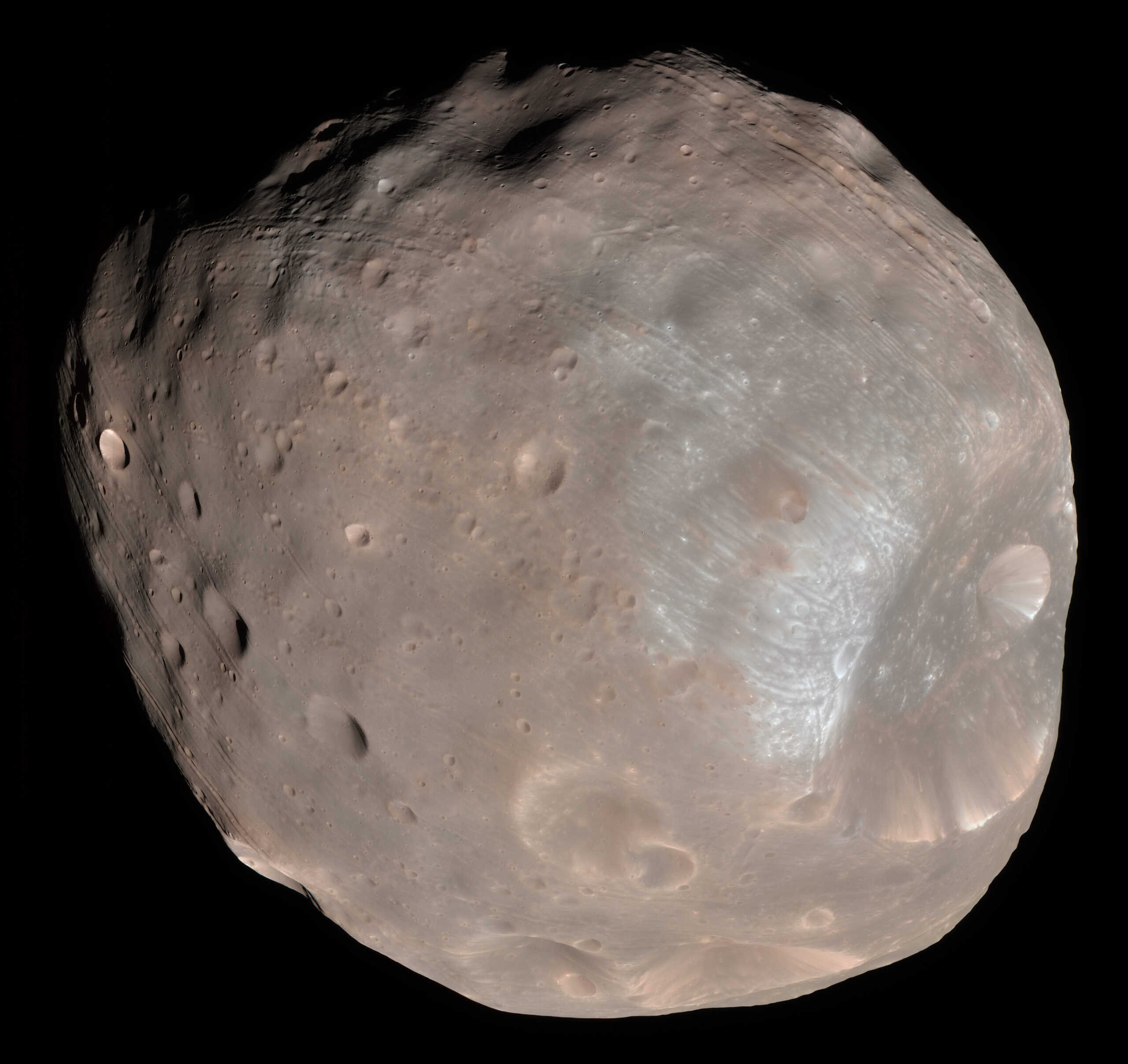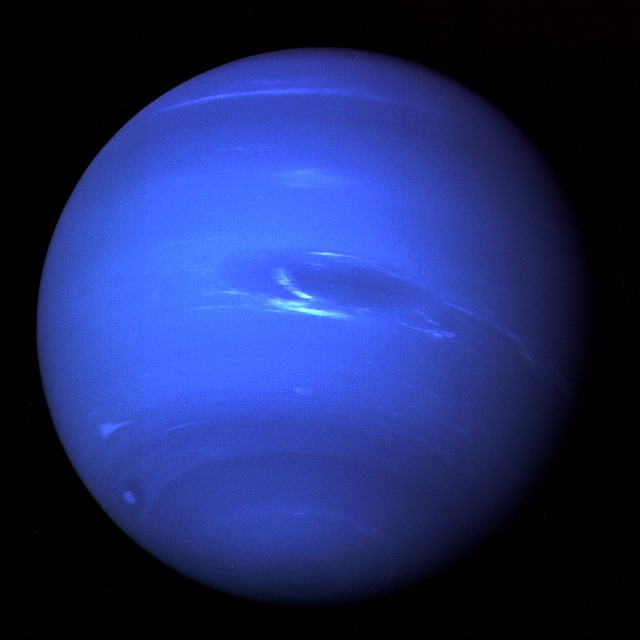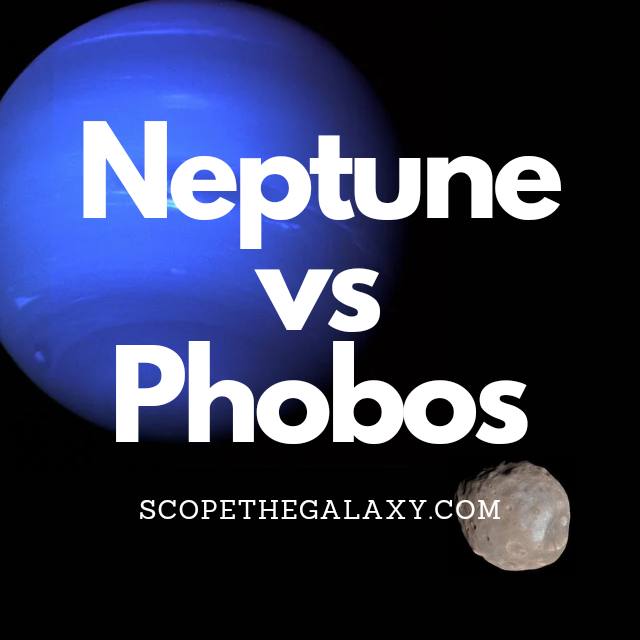*This post may contain affiliate links. This means we may make a commission if you purchase an item using one of our links*
The main differences between Phobos and Neptune are that Neptune is a gas based giant while Phobos is a natural satellite, Neptune is far bigger with a diameter of 49,244km while Phobos’ is 22.53 km and Neptune has 14 other moons orbiting it while Phobos is one of 2 moons that orbits Mars.
There are various other differences between the two so, continue reading for a more detailed look at each body along with their similarities and differences below.
What Is The Moon Phobos?
Table of Contents

Phobos is the larger and innermost of the Martian moons, named after the Greek God of fear and panic. This rocky satellite measures approximately 27 x 22 x 18 kilometers and possesses an irregular shape.
Flying only 270 km above Mars’s surface, Phobos orbits the Martian surface so closely that it spins around the planet three times a day (each orbit takes 7 hours and 39 minutes). And this proximity means that the moon cannot always be seen from Mars’ surface (it all depends on where you’re standing).
In general, Phobos rises in the west, passes through the sky in around 4 hours, and sets in the east. And this process occurs twice during one Martian day.
Phobos travels 1.8 m closer to Mars every 100 years, which means this doomed moon will one day crash into its planet or break up into rings. Still, this won’t happen for another 50 million years or so.
The moon is covered in streak patterns from impact craters, the most significant of which is the crater Stickney, with a diameter of 9.7 km. Phobos has weathered thousands of meteorite impacts, one of which almost shattered it to pieces.
It was first discovered by the American astronomer Asaph Hall on 17th August 1877. But, it can be difficult for astronomers to see as it is one of the least reflective bodies in the solar system with an albedo of 0.071.
Despite its small stature, Phobos experiences wildly varying temperatures on its dark side compared to the light side. Measurements on the light side of the moon suggest that temperatures can rise to -4 degrees Celsius, a sort of brisk winter’s day that would be cold but tolerable.
In contrast, temperatures on the dark side can drop to -112 degrees Celsius, even though the two areas are just a few kilometers apart. The probable cause is fine surface dust that cannot retain heat, allowing temperatures to drop rapidly.
The low density of Phobos suggests its composition is similar to carbonaceous chondrite meteorites, which could mean that Phobos is a captured asteroid.
What Is The Moon Neptune?

Neptune is the 8th farthest planet from the Sun and ranks among the bigger planets in our solar system. As the 8th farthest planet from the Sun, it does take Neptune a very long time to complete 1 orbital around the Sun.
This takes 165 years to complete which in comparison to the 16 hour 1 full spin around the axis is a massive difference.
In regards to its composition, Neptune is mostly made up of a thick swath of water closer to the center, methane, ammonia, hydrogen and helium molded around its Earth sized core.
As a result of the excess amount of methane and the inclusion of another undiscovered element within the atmosphere, Neptune’s color is a far deeper blue than the likes Uranus, which also has an abundantly methane based atmosphere.
The planet is 49,244km in diameter, making it roughly 4 times Earth’s diameter Earth, and would allow around 57 Earths to fit inside it. This also makes Neptune the 4th largest planet in our solar system.
Neptune is very cold mostly down to its distance from the Sun, where its atmospheric temperature sits between -220 to -230 degrees Celsius. Its core is far hotter coming in at 5,100 degrees Celsius and is the very likely cause for the liquid water present within the planet
Subsequently, the erratic temperature and gaseous composition of Neptune, is what constitute towards its turbulent behavior.
In fact Neptune has the fasted winds in our solar system, producing some that eclipse speeds of 2,000km per hour. The fastest winds on Earth would only be a fifth of these speeds at most.
At this moment in time we have discovered 14 moons orbiting Neptune and have also observed 5 thinner rings surrounding the ice giant.
Similarities Between Neptune And Phobos
There are a few similarities that Neptune and Phobos share, which in this case includes the following:
- Both are part of the same solar system.
- Neither have tectonic plates.
- Both orbit another larger object.
Differences Between Neptune And Phobos
As for the differences between the two so, they include the below:
- Phobos orbits Mars whilst Neptune only orbits the Sun.
- Neptune is a spherical shape while Phobos is not.
- Neptune has 5 rings surrounding it while Phobos has 0.
- Neptune is a gas giant planet whilst Phobos is a terrestrial based natural satellite.
- Neptune has a diameter of 49,244km whilst Phobos has a diameter of 22.53km.
- Phobos has no atmosphere whilst Neptune is an ice based gas giant and therefore, is composed of hydrogen and helium and elements of methane that contributes to the planets blue color.
- A day on Phobos takes 7 hours 39 minutes whilst a Neptune day is 16 hours.
- It takes Phobos 7 hours 39 minutes to orbit Mars and the Sun in 687 days whilst Neptune orbits the Sun in 165 years.
- Neptune has an axial tilt of 28 degrees whilst Phobos’ axial tilt is closer to 0.
- Phobos’ temperature ranges between -4 to -112 degrees Celsius whilst Neptune has an average temperature of -220 to -230 degrees Celsius.
- Neptune has 14 moons while Phobos has no moons orbiting it.
- Neptune’s density is 1.64 g/cm³ whilst Phobo’s density is 1.88 g/cm³.
- Neptune’s mass is 1.024 × 10^26 kg whilst Phobos’ mass is 10.6 × 10^15 kg.
- Phobos’ gravitational strength is 0.0057 m/s² whilst Neptune’s is 11.15 m/s².
- Phobos is tidally locked to Mars whilst Neptune is not tidally locked to anything.
- Phobos only orbits Mars 6,000km away and is getting closer to the planet by 1.8 meters every 100 years.
- Neptune has magnetosphere whilst Phobos has no magnetic field.
- Neptune has a hotter central core while Phobos does not.
Summary
Neptune and Phobos share very few similarities, which would include them being a part of the same solar system and having no tectonic activity but, they ceratinly have way more differences between themselves.
Whether it be in regards to mass, size, physical composition, orbital period, density and more they differ significantly, which is why Neptune looks and functions so very distinctly from Phobos and vice versa.

